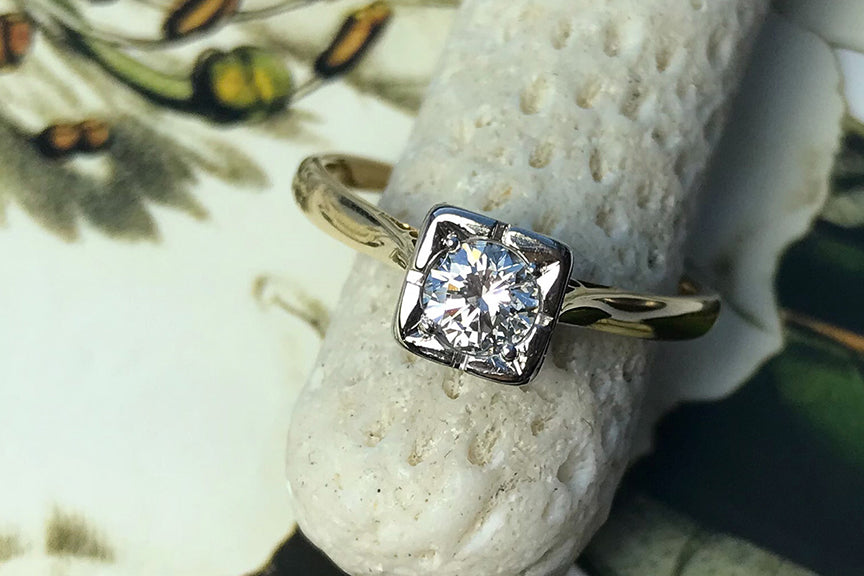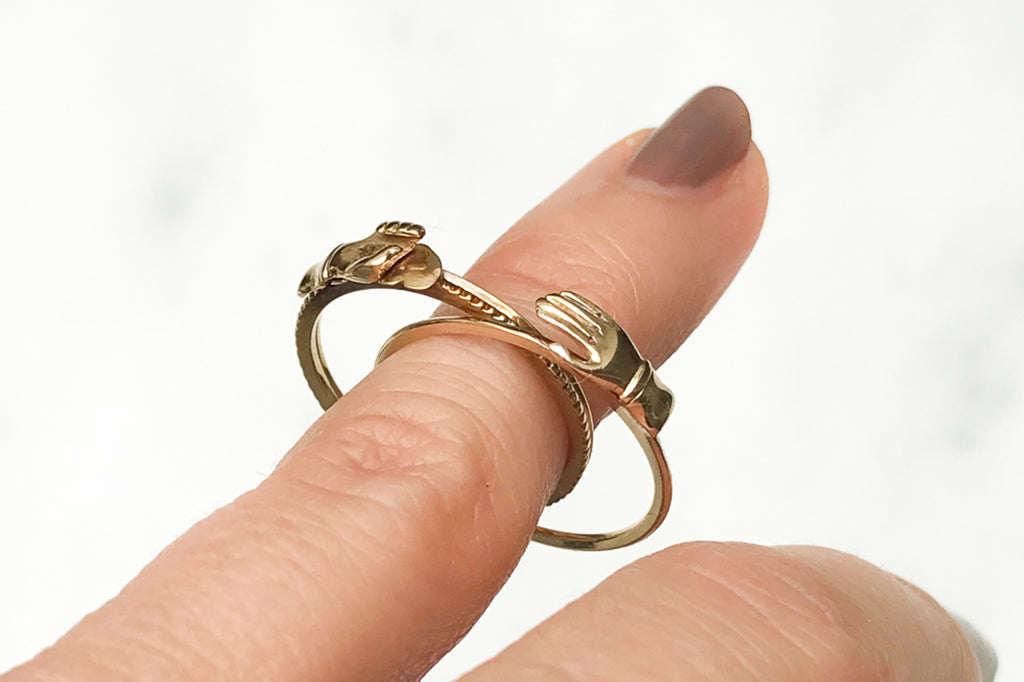
How many sizes can I resize my antique engagement ring by?
Ring sizing is a nuanced art. This is particularly true of engagement rings, which are worn every single day – whatever the weather – and vary broadly in style. Whilst wide bands tend to fit a little snugger than those that are slim, top-heavy rings have the tendency to spin around the finger if they’re not sized perfectly.
What's more, for the sake of structural integrity, we generally prefer not to resize any antique ring more than once. This is because most old rings have already been resized at least once in their lifetime, which can sometimes cause the band to become thinner and weaker. If we can help it, we’d prefer not to accelerate that process further. With this in mind, we always recommend popping the question with the ring in its original size, then organising any necessary adjustments afterwards. That way, the hand in question can be present for the resizing process.
HOW ARE ANTIQUE RINGS RESIZED?
 Our Fern ring
Our Fern ring
The traditional method for resizing a ring is cutting open its band at the back, where the design will be least significantly affected, before adding or removing metal until the ring is the right size. The opening is then soldered shut and polished to remove any tell-tale signs of amendment.
Alternatively, a plain band might be resized by the process of stretching. This involves the ring being lodged inside a compress and, with the use of cranks, either expanded or compressed. This process is not advisable for rings that are adorned, for fear of decorations becoming warped or gemstone settings being stressed to the point that they are no longer functional.
HOW MUCH CAN I RESIZE MY ANTIQUE RING BY?
 Our Charlotte and Vivienne rings
Our Charlotte and Vivienne rings
There’s no simple answer to this question; a ring’s ability to be significantly resized depends on a number of factors. Generally speaking, the more complex a ring’s design, the more complex the job of resizing it.
The rings that are easiest to adjust are those that are plain, without engravings or gemstones set into the band. The average unembellished wedding band can be sized up or down by as many as six or seven sizes. Meanwhile, the simple solitaire engagement ring is generally equipped to adapt by around four sizes either way.
Antique rings with more intricate arrangements of gemstones, engraving or metalwork on the heads and shoulders – such as our Clover, Georgina or Coco rings – require a little more caution during the resizing process, and generally aren’t as forgiving of heavy bending. For this reason, we’d never recommend having a jewel of this nature adjusted by more than three sizes. Rings with gemstones set into their bands will always require a thorough check by a skilled stone-setter following their resize, to ensure that their settings have not been compromised in anyway.
Eternity-style bands set with gemstones from start to finish are assessed on a case-by-case basis. Sometimes, it’s just not possible to add or remove any metal without totally compromising the structural integrity or design.
All of this being said, every single antique ring is unique in its own right. We recently expanded an Edwardian dress ring by nine sizes because, fortunately, its quality and structural soundness enabled us to do safely. However, another ring of a similar era and style might not boast the same level of durability. As passionate jewellery lovers, we would never perform a resize that we didn’t feel was feasible for the ring in question.
ANTIQUE JEWELLERY FEATURES TO BEAR IN MIND
 Our Clover ring
Our Clover ring
Intricate band engravings and metalwork are common of many antique and vintage styles. Ring sizing and polishing can interfere with the continuity of such detailing, so it’s worth ensuring that the jeweller resizing your ring can help you to have them retouched if necessary. On occasion, we might ask our hand-engraver to retrace an existing pattern, helping the ring to look like new again.
Whilst diamonds, rubies and sapphires are ‘cardinal’ stones that score impressively on the Mohs Scale of Hardness, gems such as emeralds, pearls and quartz are significantly softer. It’s perhaps for this reason that jewellers don’t tend to favour them for engagement ring designs in the contemporary context, but their popularity during the Victorian, Edwardian and mid-century eras makes them a regular feature of antique dress and cocktail rings. These jewels can be brittle and heat-sensitive in nature, so will probably need to be de-set for the purpose of the resizing process and replaced afterwards.
IT'S ALL IN THE SHANK
 Our Blossom ring
Our Blossom ring
By nature, antique rings have been doing the rounds for a long time. Many of them have enjoyed centuries of wear, bringing joy to a number of different wearers over the years. Naturally, this means that many have also been resized more than once – and this is often apparent in the shank. The shank is the area at the back of the band, where most rings are resized and squeezed tightly over the years. If a ring’s shank is particularly thin or has been compromised by years of wear and resizing, it might need replacing altogether.
What’s more, platinum and 18ct gold aren’t always consistent in colour; one ring might show a slightly different hue to another of the same metal. When a ring has been resized, the solder re-joining its band might stick out a little as different in shade to the rest of the ring. This isn’t always noticeable in the first instance, when the ring is freshly polished and boasting a lovely gleam; often it’s a discrepancy that makes itself apparent over time. Unfortunately, this is tricky to fix – which is why we ask our clients to embrace it as a quirk which symbolises a life well lived.
GETTING YOUR ANTIQUE ENGAGEMENT RING RESIZED
 Our Maggie, Blossom and Bridget rings
Our Maggie, Blossom and Bridget rings
Here at The Vintage Ring Company, we offer one free resize within the first year of purchase. It’s a process which usually takes around three weeks and can either be organised remotely – via post and the help of one of our at-home ring sizing gauges – or in person at the London Diamond Bourse. Drop us an email if you need our help.


